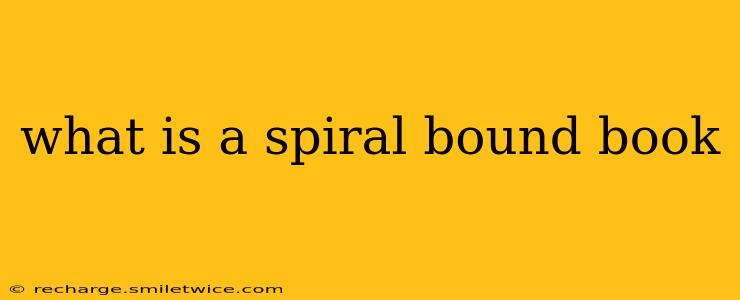A spiral-bound book, also known as a coil-bound book or wire-o-bound book, is a type of bookbinding where pages are punched with holes down the spine and then attached using a plastic or metal comb-like binding mechanism. This creates a durable, lay-flat binding that allows the book to open completely flat, making it ideal for various applications. Let's delve deeper into the specifics.
How is a Spiral Bound Book Made?
The process of creating a spiral-bound book involves several key steps:
-
Page Preparation: The pages are printed or copied and then collated in the correct order.
-
Punching: Holes are punched along the spine of the collated pages using a specialized machine. The hole spacing and size depend on the binding mechanism used.
-
Binding: The spiral binding coil is then inserted into the punched holes. The coil's prongs are carefully closed and crimped, securely fastening the pages together.
-
Finishing (Optional): Some spiral-bound books may include additional finishing touches, such as cover lamination or a cover that is separately printed and then attached.
What are the Advantages of Spiral Binding?
Spiral binding offers several advantages over other binding methods:
-
Lay-Flat Design: This is arguably the biggest advantage. The book opens completely flat, making it easy to write in, draw on, or take notes alongside the text. This is particularly useful for notebooks, calendars, and workbooks.
-
Durability: The spiral binding is strong and resistant to tearing, making it suitable for frequently used books.
-
Cost-Effectiveness: Compared to other binding methods like perfect binding or case binding, spiral binding is often a more affordable option, especially for smaller print runs.
-
Customization: You can easily customize the number of pages, cover material, and even the color of the spiral coil to create a unique book.
What are the Disadvantages of Spiral Binding?
While spiral binding has many benefits, it also has some drawbacks:
-
Limited Page Capacity: Spiral binding isn't suitable for extremely thick books, as the coil can become unwieldy and prone to damage.
-
Prone to Damage: While durable, the coils can sometimes bend or break if the book is mishandled or dropped. The pages can also tear out if excessive force is applied.
-
Not as Elegant: Compared to some other binding methods, spiral binding can appear less elegant or formal, making it less suitable for high-end publications.
What are Spiral Bound Books Used For?
Spiral binding is popular for a wide range of applications:
-
Notebooks and Journals: The lay-flat design makes them perfect for note-taking and journaling.
-
Workbooks and Exercise Books: Ideal for educational materials requiring student interaction.
-
Calendars and Planners: The ability to easily turn pages makes them useful for scheduling and planning.
-
Recipe Books: The lay-flat design prevents the pages from closing when you're cooking.
-
Presentations and Portfolios: Provides an easy-to-navigate format for presenting information.
What are the Different Types of Spiral Binding Coils?
You'll typically find two main types of spiral binding coils:
-
Plastic Coils: These are the most common and come in various colors. They are generally less expensive.
-
Metal Coils: These are more durable than plastic coils but also more expensive. They offer a more professional look.
Is Spiral Binding the Right Choice for My Project?
The suitability of spiral binding depends on your specific needs. Consider the number of pages, intended use, budget, and desired aesthetic when making your decision. If you need a durable, lay-flat binding for a relatively thin book and cost-effectiveness is important, spiral binding is likely a good choice. If you need a more formal or high-end look, you might consider other binding options.
